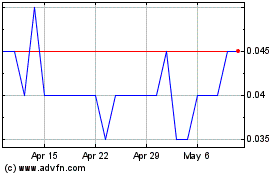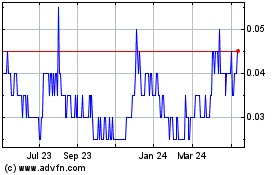Klondike Silver Corp. Commences Drilling on Highly Prospective Segment of the 'Main Lode' Structure on Silver Ridge
29 May 2009 - 1:20AM
Marketwired Canada
Klondike Silver Corp. (TSX VENTURE:KS) (the 'Company') is pleased to announce
that diamond drilling has started from their new underground west extension of
the main access '4625 Level' of the Silvana mine. This is the first stage of
exploration on a 7,000 foot (1.5 km) long presumed highly prospective segment of
the productive and historic 'Main Lode' structure which is the principal source
of the Slocan mining camp's silver/lead/zinc production.
The Main Lode is over 5 miles (8 km) long, extending from Silverton on Slocan
Lake in the west to Sandon in the east through the 'Silver Ridge' of the Selkirk
mountains some 30 miles (50 km) north of Nelson, BC.
The Silvana production (see below) arose from a length of just less than one
mile (1.5 km) of the Main Lode under Silver Ridge, westerly from the Silversmith
mine, a former major producer near Sandon. The Company holds approximately 1.5
km of the ground to the west of this productive zone, to within a quarter of a
mile (0.5 km.) of the Mammoth mine. By way of drifting and current drilling the
Company is testing the first 0.2 km of the 1.5 km gap in exploration of the Main
Lode at an elevation of 4,600 to 5,000 feet (1,400 to 1,500 meters). This
programme represents the first attempt since the early 1990's to step out
westerly towards the Mammoth and the other major Main Lode producers towards
Silverton.
Mineralized surface outcroppings discovered in the 1890's led to the start of
production from this structure in its distal segments. The westerly segment
hosted (from W to E) the Standard mine which is the largest producer of Ag and
Pb in the camp, and the Hecla, Monarch and Mammoth deposits, over a distance of
some 2 miles (3.2 km). The easternmost segment of over a mile (2 km) hosted
(from W to E) the Hope, Silversmith, Slocan Star and Richmond-Eureka deposits.
About 1.5 million tons of ore were locally processed or direct-shipped from
these operations. Aggregate recovered production to 1964 from the west segment
was 9.5 million ounces of silver, 45,000 tons of lead and 60,000 tons of zinc.
The easterly segment yielded approximately 9 million ounces of silver, 43,000
tons of lead and 13,000 tons of zinc. (The disparity between zinc tons recovered
from east and west Main Lode mine groups is from the earlier-developed eastern
group having recovered a much smaller percentage of zinc in processing or by
avoiding 'zincy' material when the metal was less sought after or difficult to
recover using the technology available at the time.)
Almost all of this production arose from a zone within the Main Lode lying
between roughly 4,000 feet (1,200 meters) and 5,500 feet (1,700 meters)
elevation. The central unexplored portion of this prospective deep zone passes
for 2.5 miles (4 km) beneath the 5,000 (1,500 meters) to nearly 8,000 feet
(2,400 meters) approximate elevations of steep-sided Silver Ridge. It received
initial underground exploration westerly from the Silversmith mine area by the
Kelowna Exploration Company in the late 1940's using a programme of lateral
drift mining and diamond-drilling.
A similar but extensive programme was started in late 1962 westwards from the
Kelowna work by the "Silmonac Syndicate". Their persistence was rewarded in 1967
with the discovery from underground via diamond drilling of a Ag/Pb/Zn
mineralized section of the Main Lode (not recognized definitively as such at the
time). That section was explored, developed and mined from by Silmonac's
successors including Kam-Kotia Mines Limited, Silvana Mines Inc., Dickenson
Mines Limited and Treminco Resources Ltd. almost continuously from 1970 to 1993,
and now by Klondike Silver.
Production to date is about 8 million ounces of Ag and over 30,000 tons each of
Pb and Zn from some 550,000 tons of mill feed, representing 30% of the area
silver and 25% of its lead production. This makes the Silmonac/Silvana operation
easily the second largest single producer of silver and lead in the Slocan camp
after the Standard Mine. Noteworthy is that the silver-ounces-to-lead-percent
ratio from the Silvana production has been higher than that from the Standard
mine production, an enhancement that improves the economics of Silvana's typical
mill feed.
For a map of the 2009 target drilling are click on the following link:
http://www.klondikesilver.com/i/pdf/2009-05-28_NRM.pdf
The technical information in this news release has been prepared in accordance
with Canadian regulatory requirements set out in National Instrument 43-101. Mr.
Edward Craft (P.Eng.) is designated as the qualified person who reviewed and
approved the contents of the press release.
About Klondike Silver
Klondike Silver Corp. has assembled a quality portfolio of silver and
silver-rich poly-metallic properties in historic mineral districts in North
America, and is applying advanced exploration technologies to add value to these
core assets. Klondike Silver is reviving the Gowganda and Elk Lake silver camps
in Ontario, and the world-famous Klondike district of Yukon Territory. The
Company owns a 100 TPD fully operational flotation mill in Sandon, BC, which is
currently processing material from one of its Yukon properties and local mines
in the historic Slocan Silver Camp.
The statements made in this Press Release may contain forward-looking statements
that may involve a number of risks and uncertainties. Actual events or results
could differ materially from the Company's expectations and projections.
Klondike Silver (TSXV:KS)
Historical Stock Chart
From Dec 2024 to Jan 2025

Klondike Silver (TSXV:KS)
Historical Stock Chart
From Jan 2024 to Jan 2025
